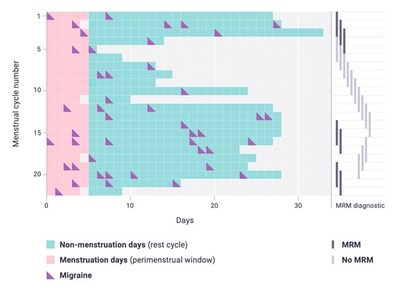TMCnet News
Menstrual Migraine Guidelines Challenged in New Study by Curelator- The current study[1] is the first study to systematically look at menstrually-related migraine (MRM) characteristics among women, and within each woman over multiple menstrual cycles: 203 women tracked their migraine symptoms over a median of 150 days and 7 menstrual cycles per woman, using Curelator's app, N1-Headache™. - Most surprising was the finding that the relation between menstruation and migraine varied more within an individual woman (cycle to cycle) than between women. - International Classification of Headache Disorders 3rd Edition (ICHD-3) definition of MRM requires migraine headache to occur during the perimenstrual period on at least 2 of 3 consecutive cycles. Given the large within-woman variability found, the current recommendation of just keeping diaries during 3 months may lead to many missed diagnoses. CAMBRIDGE, Mass., Oct. 18, 2021 /PRNewswire/ -- Curelator Inc. announced new data that, once again, challenged the age-old practice of applying 'population-based' guidelines to all individuals, this time with respect to diagnosis and treatment of menstrually-related migraine. The results of a collaborative international study, published in March in the leading medical journal, Headache, underscored the need for a personalized approach through individual analysis of a patient's longer-term headache data. Menstruallyrelated migraine is common and burdensome; research suggests that the association between migraine and menstruation is self-reported by almost 60% of women with migraine. However, for many women the relationship between their migraine attacks and menstruation is unclear. Recent advances in the ability to digitally capture and analyze high-resolution, longitudinal, individually reported patient data, such as with the N1-Headache™ platform, have allowed for greater insight into the relationship between occurrence of migraine attacks in an individual and their menstrual cycles. This is the first study to attempt to disaggregate and understand how the relation between menstruation and migraine varies, not only among the women in a population, but also in each particular woman, from cycle to cycle - allowing us to better understand what happens in an individual. The study included 203 women who tracked their migraine over multiple menstrual cycles (median 150 days and median 7 menstrual cycles per woman) using Curelator's app, N1-Headache™. Population estimates confirmed previous findings that migraine days are more common during the perimenstrual period (2 days before to 3 days after start of bleeding) than at other times (34% increase in odds). Diagnosis of menstrually-related migraine requires migraine headache to occur during the perimenstrual period on at least 2 of 3 consecutive cycles (according to ICHD-3 guidelines). One may expect that a woman with this diagnosis consistently presents with a migraine attack twice every three menstrual cycles. However, this study found that, at the individual woman level there is a surprisingly large variability between cycles: in women who satisfied the diagnosis criteria of menstrually-related migraine in at least one set of 3 consecutive cycles, their data showed that there were other sets of 3 consecutive cycles in which there was no -or just one- attack around the time of menstruation. There was also marked variability between women but the difference was less than the within-woman variability from cycle to cycle. "The central clinical takeaway from this work is that the treatment of menstrual migraine requires a patient-centric approach and rigorous examination of individual patients' longer-term headache histories." Commented Jim McGinley, Ph.D., Director of Behavioral Analytics at Vector Psychometric Group. Jelena M. Pavlovic, M.D., Ph.D., Associate Professor at the Saul R. Korey Department of Neurology at Albert Einstein College of Medicine, added, "The study emphasizes that clinicians and patients recognize that menstruation can affect migraine in women in many different ways. In order to get a better sense of how menstruation and migraine are related in a given woman, diaries (preferably electronic diaries) should be kept for longer periods of time rather than the currently recommended three months." Reference 1 McGinley JS, Wirth RJ, Pavlovic JM, Donoghue S, Casanova A, Lipton RB. Between and within-woman differences in the association between menstruation and migraine days. Headache. 2021 Mar;61(3):430-437. doi: 10.1111/head.14058. Epub 2021 Feb 19. PMID: 33605450. About Curelator Founded in Cambridge, Massachusetts, in 2013, Curelator is a data-driven digital health company focused on developing clinical grade, personalised disease management tools for patients and clinicians. Since its inception, Curelator has published dozens of papers and abstracts in major headache and migraine journals and conferences, and it has enrolled thousands of patients on clinical studies through its N1-Headache™ platform. About N1-Headache™ N1-Headache™ is a unique patient engagement platform that delivers personalized, disease management tools for people with a history of migraine or medication overuse, allowing them to understand their migraine attack patterns in an individualized manner. This personalized information enables patients and their healthcare providers to manage individual migraine risk factors, assess therapeutic response to drugs and identify opportunities to prevent medication overuse. Contacts for additional information: Curelator Photo - https://mma.prnewswire.com/media/1661400/Curelator_MRM_Study.jpg 
|


